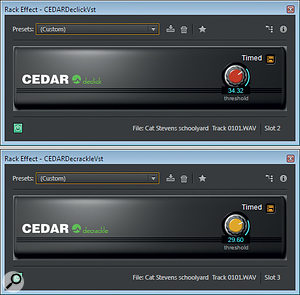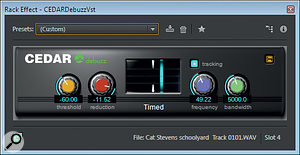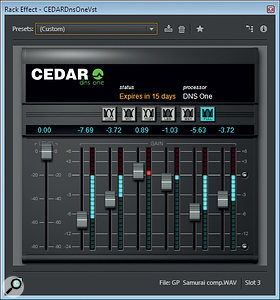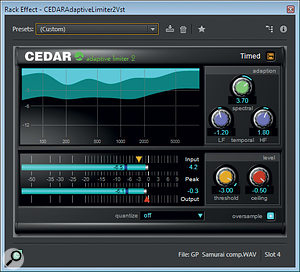With the VST protocol now supported, more people than ever can use CEDAR’s industry-standard restoration tools.
CEDAR Audio are the only company in the world dedicated exclusively to developing audio restoration and speech enhancement products for the music, film, TV and forensic industries — a pretty niche market! For the uninitiated, the company’s origins lie in a five-year research project on digital audio restoration techniques funded by the British Library National Sound Archive. After the project ended in 1988, those involved set up CEDAR as an independent company to market and further develop the pioneering technologies they had created. Since those early days, the company has gained an unparalleled reputation all over the world for its sophisticated range of cutting-edge restoration tools and systems.
The company’s new Studio 6 plug-in suite takes over from the original CEDAR Studio and Studio AAX offerings, and provides seven audio restoration tools licensed either as a complete set, in related groups, or individually (see Pricing box). These are available in both AAX and VST (2.4) formats on both Mac OS and Windows. Licensing is based around CEDAR’s HSP dongle system, with unique authorisation codes for each active plug-in entered via a simple but effective Licence Manager program.
Why Make It Complicated?
The seven plug-ins are all derived from previous offerings, and four will be immediately familiar to users of the CEDAR Studio 5 suite: the Adaptive Limiter, Debuzz, Declip and DNS One (dialogue noise suppressor) plug-ins. Studio 6 introduces three more processors called Declick, Decrackle and Auto Dehiss, derived from processes available for CEDAR’s flagship Cambridge platform. These are modern versions of three restoration tools that first appeared between 1990 and 1994, and will be very familiar to anyone with previous CEDAR experience. All of these plug-ins are carefully optimised to provide the best possible results quickly and easily, with minimal user controls and intervention, and with relatively light CPU loading.
CEDAR’s audio restoration tools stand apart from the competition in two main ways. Firstly, when used correctly, they deliver restored audio files which just don’t sound processed at all. Secondly, they are all astonishingly easy to use and fine-tune for the material being processed (or for client preferences concerning the amount of restoration applied). Most of the plug-ins employ only two or three user controls, which are cleverly designed to adjust multiple parameters behind the scenes, in exactly the way your ears expect. As a result, CEDAR’s tools may appear simplistic in comparison to competing plug-ins that bristle with editing parameters. However, considerable skill, knowledge and time is required to optimise these kinds of processes for any given situation. CEDAR’s algorithms analyse the audio in a sophisticated way and come up with near-perfectly optimised settings every time, but with exactly the right options to further shape the processing if required.
Hiss Off
The first of the ‘new’ plug-ins in Cedar Studio 6 is Auto Dehiss, which employs what CEDAR describe as “a very advanced algorithm” to identify the broadband noise content that should be removed from the signal. This is a descendant of one of the company’s earliest processors, and was originally conceived to deal with analogue tape hiss. It works particularly well in reducing the audibility of high-frequency hiss without introducing unwanted artifacts such as ‘twittering’ or ‘glugging’, and when used delicately, is quite uncanny in the way it avoids any dulling of the wanted source sound. An attenuation control adjusts the amount of noise reduction applied, as you might expect, but the real cleverness is found in the two ‘bias’ controls (one for the overall broadband noise, and one for the low-frequency end of the spectrum). These help to steer the algorithm to achieve the desired level of transparency or efficiency of noise reduction. A fully manual mode is also available, again with just three user parameters. The Attenuation and LF bias controls remain, but the main Bias control changes to ‘Threshold’.
 The original Declick was another of CEDAR’s early commercial products, and the new version is claimed still to be better than any other impulsive noise detector and interpolator system currently available for Pro Tools or as a VST plug-in. Originally intended for removing clicks from dirty and damaged records, it can also be used to remove other kinds of impulsive noise, such as necklaces colliding with lapel microphones, or digital clocking glitches.
The original Declick was another of CEDAR’s early commercial products, and the new version is claimed still to be better than any other impulsive noise detector and interpolator system currently available for Pro Tools or as a VST plug-in. Originally intended for removing clicks from dirty and damaged records, it can also be used to remove other kinds of impulsive noise, such as necklaces colliding with lapel microphones, or digital clocking glitches. When restoring antique records, Declick is often used in concert with the Decrackle tool, and for that reason, Declick and Decrackle are sold together as a pair in the Studio 6 suite for the same price as other individual plug-ins. First released in the form of the CR1 hardware processor, Decrackle was designed to remove low-level crackles from records, but it is also helpful with other background grunge and buzzes. Both the Decrackle and Declick plug-ins are equipped with a single user control labelled Threshold, which determines the level of damage needing repair. Having a single adjustment parameter might seem laughably restrictive, but a few minutes’ use easily reveals just how clever and powerful these controls really are.
When restoring antique records, Declick is often used in concert with the Decrackle tool, and for that reason, Declick and Decrackle are sold together as a pair in the Studio 6 suite for the same price as other individual plug-ins. First released in the form of the CR1 hardware processor, Decrackle was designed to remove low-level crackles from records, but it is also helpful with other background grunge and buzzes. Both the Decrackle and Declick plug-ins are equipped with a single user control labelled Threshold, which determines the level of damage needing repair. Having a single adjustment parameter might seem laughably restrictive, but a few minutes’ use easily reveals just how clever and powerful these controls really are.
Decrackle can help with some kinds of background buzzes, but CEDAR Studio 6 also offers a dedicated tool for this job, called Debuzz. This is specifically designed to remove a wider range of audible hums and quite complex buzzes with fundamental frequencies of up to 500Hz. It is also able to track and remove nasties that wander in pitch too, which is an unusual but immensely powerful feature. This is one of the few modules that employs a graphical display, in this case designed to help identify the hum frequencies. Four controls are provided: two to identify the fundamental frequency and bandwidth, and two to adjust the threshold and required attenuation.
This is one of the few modules that employs a graphical display, in this case designed to help identify the hum frequencies. Four controls are provided: two to identify the fundamental frequency and bandwidth, and two to adjust the threshold and required attenuation.
Clip Joints
Declip also features a graphical display, this time to help identify the clipped portions of the audio signal, as well as input and output meters. Once the clipped regions are identified on the positive and negative halves of the waveform (they tend to manifest as small ‘horns’), the damaged peaks are removed and the waveform intelligently reconstructed to eliminate the distortion and restore virtually the original dynamic range. It is an impressively transparent process even when running with the ‘heavy’ algorithm, but there is also a ‘light’ option for less serious cases, as well as a gain control to restore some headroom after the waveform reconstruction.
It is an impressively transparent process even when running with the ‘heavy’ algorithm, but there is also a ‘light’ option for less serious cases, as well as a gain control to restore some headroom after the waveform reconstruction.
The DNS One plug-in is a software version of the original DNS1000 dialogue noise suppressor, which has become ubiquitous in the broadcast and film industries for cleaning up noisy dialogue tracks, both live and in post-production. In addition to reducing general background noise, it can also help in suppressing the fan noise of remote-controlled lighting and display walls in TV studios, air-con rumbles, hisses and whistles, and even in bringing excessive reverberation under control. Pro Tools users can use the related DNS CS controller, too, which can control hundreds of channels of noise suppression from any combination of DNS One software or DNS2000/DNS3000 hardware processors. The DNS One is equipped with seven virtual faders, one setting the noise level, and the others controlling the noise attenuation applied in different frequency bands, the operating bandwidths being selected by six buttons above the faders. Bargraph meters alongside each fader indicate the corresponding processing activity.
Pro Tools users can use the related DNS CS controller, too, which can control hundreds of channels of noise suppression from any combination of DNS One software or DNS2000/DNS3000 hardware processors. The DNS One is equipped with seven virtual faders, one setting the noise level, and the others controlling the noise attenuation applied in different frequency bands, the operating bandwidths being selected by six buttons above the faders. Bargraph meters alongside each fader indicate the corresponding processing activity.
Finally, there’s the Adaptive Limiter 2 plug-in. Perhaps not an obvious inclusion in a suite of audio restoration tools, it is nevertheless a stunningly effective limiter which works in a very unusual way. Standard limiters simply detect the peak amplitude and attenuate the entire signal accordingly, while multi-band limiters divide the audio spectrum into two or three separate bands and apply conventional limiting to each band independently. Adaptive Limiter takes an entirely different approach: it calculates a varying EQ profile to constrain the output level at different frequencies. It is claimed that this retains the integrity of the rest of the wanted signal, and in practice it sounds extremely natural and transparent, while also being exceptionally accurate in controlling peak levels. These properties make it ideally suited as a ‘maximiser’ for mastering applications, of course. Again, a graphical display is involved to illustrate the dynamically changing minimum and maximum attenuation being applied across the spectrum, and separate meters show the input and output levels.
The limiter has five user controls, but only the Threshold and Ceiling parameters will be immediately familiar. The three other controls are in a section labelled ‘adaption’ and they control the overall spectral and temporal behaviour (how quickly the curve adapts at the high and low ends of the spectrum). The action of these controls is complex and yet remarkably intuitive, and allows an enormous range of limiting behaviours and characteristics to be achieved very easily by ear.
Instant Rewards
The original CEDAR audio restoration hardware processors of the mid-’90s were revolutionary, and the ever-increasing availability of computer processing power has allowed CEDAR to fine-tune their algorithms further, with recognisable progress in both usability and sonic transparency. That same increase in available computing power has also changed the way we work, with the vast majority of audio post-production today being done using DAW plug-ins rather than outboard hardware. So the release of such a versatile suite of restoration tools in both the AAX and VST formats is very welcome — and the latter especially so, as it also enables integration with the growing number of broadcast and live-sound digital consoles that support real-time VST plug-ins.
My attempts to install the Studio 6 suite on a 64-bit Windows 7 PC resulted initially in failure, but that turned out to be because I deselected unwanted AAX plug-in options. Leaving the installer to run its default settings proved successful, and after cutting and pasting the seven licence codes into the License Manager, I was able to load and use the VST plug-ins into all of my DAWs: SADiE 6.11, Reaper 4.75 and Adobe Audition CC6. The CEDAR boffins are looking into this minor PC install bug, and it should be resolved by the time you read this.
Nothing with a CEDAR logo can be considered cheap, but we are talking about class-leading and cutting-edge technology here, and while other solutions may be considered more cost-effective in some circumstances, I know of none that are as good, let alone better. The option to buy individual Studio 6 plug-ins will appeal to many potential customers, although it obviously becomes cheaper to buy the full suite if you require any more than two plug-ins.
It is my experience that the key to using audio restoration tools is to remember that the aim is to make things better, rather than to make them perfect: to reduce unwanted noises rather than to remove them completely. Having said that, it is certainly possible in some situations to achieve miraculous perfection, and if any restoration tools can touch that holy grail, CEDAR’s will be the most likely to succeed first time! However, more usually it’s about making the sound as good as possible without doing any damage, and often a few gentle passes will produce far better results than a single heavy-handed attempt.
I have used CEDAR tools many times in the past, and I found the VST versions in the Studio 6 suite to be as easy to use and as astonishingly efficient and transparent as ever, not just in removing the unwanted noises, but doing so without introducing the annoying artifacts that can afflict lesser systems and which are often more disturbing than the original problem! Of course, different people have very different (and often unrealistic) expectations about what audio restoration should deliver, and there’s always a compromise to be found between not affecting the wanted signal at all and reducing or removing the unwanted noises sufficiently. For that reason, simplistic ‘before and after’ audio examples tend to be too subjective and counterproductive, but CEDAR are always happy to offer prospective customers a free sample of what can be achieved using their tools on any supplied test material. I would urge anyone seriously interested in acquiring CEDAR products to take them up on this offer. I have never been disappointed with the results achieved using any of CEDAR’s restoration tools, and the flexibility and convenience of the Studio 6 plug-ins makes them more attractive than ever, and easier to integrate with modern workflows. Highly recommended.
Alternatives
Many companies offer restoration tools of various kinds — click removers, fingerprint noise removers, hum filters and so on — either bundled with DAWs or as discrete plug-ins. However, the most obvious and comparable alternative to CEDAR’s Studio 6 suite is undoubtedly iZotope’s RX4 Advanced. This powerful suite of restoration tools is close to a 10th the price of the CEDAR suite, and is consequently extremely good value for money but it isn’t as fast or easy to use, and takes a lot more effort to achieve comparable results.
Pros
- A versatile suite of world-leading, cutting-edge restoration tools.
- Incredibly simple and intuitive user interfaces.
- The most transparent and powerful algorithms currently available.
Cons
- If only the best will do, you’ll need deep pockets.
Summary
Seven of the world’s best audio restoration tools are now available in convenient plug-in formats, either as a complete suite or as individual processes.
information
CEDAR Audio +44 1223 881771
CEDAR Audio USA +1 207 828 0024.
